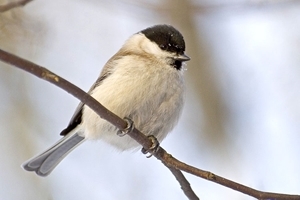Marsh tit
 Weekends are like busman holidays to me. I am generally out walking, birding or visiting local sites with my family, passing on the nature bug to my next generation. But the weather has not exactly been playing ball; it seems as though we have a repeat of last year’s cold spring.
Weekends are like busman holidays to me. I am generally out walking, birding or visiting local sites with my family, passing on the nature bug to my next generation. But the weather has not exactly been playing ball; it seems as though we have a repeat of last year’s cold spring.
However, we managed a whole day in the woods looking at ancient woodland indicator species flooding the forest floor in the sunshine; the bluebells are on their way and the wood anemones are in abundance, like constellations of stars thrown out across the woodland floor. But amidst botanical splendour, we were surrounded by the calls of very noisy tits, the marsh tit (Poecile palustris) in particular. So much so, even my little daughter asked what was that bird that was shouting!
The marsh tit is a small but bold native bird, which is part of the tit family. It is mainly brown bird, with a shiny black cap, dark bib and pale belly, weighing in at just 10-13g with a wingspan up to 19.5cm. Marsh tits are widely distributed in England and Wales and favour mature deciduous woodland habitat with a good understory – rather than marshland habitat as the name would unhelpfully suggest!
They are quite particular about the woodlands too. The trees must be above 15m tall, with a canopy that closes up to 80% in full leaf and an understory that covers 40% of the woodland floor, which should be no more than 4m in height. So, if this bird got renamed, it should definitely be the ‘particular woodland tit’!
They are rarely seen in great numbers together, as they generally are solitary birds or seen in pairs, and the adults will stay on or near to their territory all year round. So if you see one frequently in the same area, it is likely to be the same individual.
The marsh tit looks nearly exactly the same as the willow tit (Poecile montanus), and they present one of the most difficult identification challenges, so care is needed to identify these species in the field. So much so that ornithologists didn’t realise there were two species until 1897!
Both species are of conservation concern, as both have declined significantly and are red listed, with the marsh tit being added in 2022. There is one very reliable way to distinguish between the two species, and that is by their song, as they are very different. The marsh tit has a scolding, explosive sneeze like ‘pitchuu’ call, whereas the willow tit call is very nasal ‘chay-chay’ call followed by a ‘zee-zee’. However, if you see a bird that is silent, it is fair to say that you have quite a challenge ahead of you if you wish to identify it!
Much has been written about how to identify these two species, but in practice there seems to be a lot of crossover in these so-called distinguishing features. However, I have found that the best single visual feature, which is deemed reliable, is the presence of a pale white spot on the upper mandible (top part of the beak) nearest the head of the marsh tit. This is easy to see as you watch the bird move around in the field, but strangely harder to spot in photographs. Even with this top tip, sometimes it’s hard to identify this species if you have a silent bird, and you may have to accept that you have a bird that you cannot identify to the species – which grates me!
The species nests in natural holes (although may take to nest boxes) and normally lays a single clutch of 7-9 eggs each spring, which are incubated for 14-16 days. The chicks then fledge between 18 and 21 days and disperse a few kilometres from their parents’ territory. The average lifespan is two years, with breeding typically in the first year, but the maximum age from ringing recorded is 11 years and 3 months!
What do they eat?
They feed mostly on insects, seeds and berries, often caching food over winter if they find a good supply, and can sometimes be spotted in a garden on a feeder.
Reason for decline
The UK population shows a downward trend since the mid-1960s, with reasons of decline being unknown, but is possibly underpinned by a negative trend in annual survival associated with habitat degradation, which may include changes in woodland structure due to deer grazing/browsing, lack of woodland management, increased fragmentation of woodlands, and species isolation.
So, keep an eye out for this elusive, sometimes overlooked tit, listen out for the scolding, explosive ‘pitchuu’ while you are out in the woodlands this spring, and if you are planning any woodland management, have a mind for this little declining but bold species.
Megan Lock
Advisory
Image credit: Sławek Staszczuk